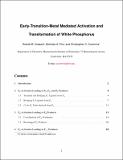Early-Transition-Metal-Mediated Activation and Transformation of White Phosphorus
Author(s)
Cossairt, Brandi M.; Piro, Nicholas A.; Cummins, Christopher C.
DownloadMain article (4.713Mb)
PUBLISHER_POLICY
Publisher Policy
Article is made available in accordance with the publisher's policy and may be subject to US copyright law. Please refer to the publisher's site for terms of use.
Terms of use
Metadata
Show full item recordAbstract
Phosphorus-containing molecules are ubiquitous in the world around us and the synthetic and industrial
utilization of phosphorus has prospered for over a century. The industrial reduction of
phosphate rock (apatite, Ca[subscript 10](PO[subscript 4])[subscript 6](X)[subscript 2], X = OH, F, Cl, or Br) to white phosphorus, P[subscript 4], exceeds
500,000 tons annually as P[subscript 4] still represents the major commercial P-atom source for the
production of organophosphorus compounds utilized by the food, detergent, specialty chemical,
and pharmaceutical industries. The present day synthesis of organophosphorus compounds is a
multi-step process in which P[subscript 4] is first chlorinated to generate PCl[subscript 3], which in turn is functionalized
by reaction with an appropriate Grignard or organolithium reagent, or by treatment with a halogenated
organic compound and a powerful reducing agent. For example, the industrial method
for triphenylphosphine preparation is based on the high temperature reaction of chlorobenzene
with phosphorus trichloride in the presence of molten sodium. From both a safety and a sustainability
standpoint, the need for PCl[subscript 3] as an intermediate for the production of organophosphorus
compounds is unpalatable and methods that circumvent its use are of great interest. This has provoked
intensive investigations into the mild and controlled activation of P[subscript 4], a clear objective being
the development of catalytic methods for phosphorus incorporation into organic molecules.
Date issued
2010-02Department
Massachusetts Institute of Technology. Department of ChemistryJournal
Chemical Reviews
Publisher
American Chemical Society
Citation
Cossairt, Brandi M., Nicholas A. Piro, and Christopher C. Cummins. “Early-Transition-Metal-Mediated Activation and Transformation of White Phosphorus.” Chemical Reviews 110.7 (2010) : 4164-4177.
Version: Author's final manuscript
ISSN
0009-2665
1520-6890